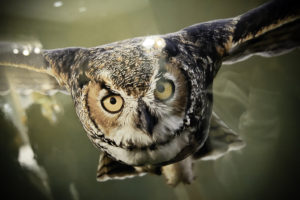My wife Lisa’s greatest joy — after her husband, of course, and our ungrateful, unappreciative daughter — is her enjoyment of wild birds. We (well, she) has a couple of large, impervious-to-squirrels feeders set up outside of our kitchen window, and Lisa will spend hours photographing the birds that come to take advantage of the seemingly endless supply of seed that is there for the taking. One characteristic of birds, however, is that they are slobs. They drop seed, they leave husks, and…well, you know the rest. We as a result get a nightly show in the form of nocturnal creatures gathering at night beneath the feeders in a heartwarming tableau. The opossums are first to arrive. They get there early to begin eating the seed that has been left on the ground. They eventually, however, are rudely shoved aside by the raccoons, the neighborhood bully boys who push aside the opossums as if they aren’t even there. The collective attitude of the masked bandits changes quickly, however, when the skunks arrive. Their “outta my way, kid” demeanor quickly changes to, “Oh, my, hello, Mr. Skunk! How nice to see you! We’ve been saving this pile of seed just for you.” Skunks are just so gentle and shy and cute as they walk up and begin eating. They don’t take any mess, however. I did see a young raccoon, one who apparently didn’t get the memo, try to nudge a skunk out of its way. The skunk engaged in some non-violent resistance, turning around and putting his tail up, resulting in three raccoons setting new distance and reaction records for standing side jumps. I didn’t know raccoons could jump sideways. They apparently can, if properly motivated.
What do those cute vignettes have to do with writing? Quite a bit, actually. After you’ve been writing for a while, you’re going to get the sense of what works and what doesn’t for you. Write what works for you. If you are good at writing action scenes but poor at writing dialogue, go with the explosions and karate and make you characters strong and silent. If you’re not able to write a convincing love scene without embarrassing yourself, don’t entangle your character in anything other than barb wire. If you can write great sex scenes but drop the thread on complex mysteries, keep the mystery simple and secondary to the amorous scenes in the bedroom or elsewhere. Our friend the opossum’s main strengths are to convincingly play dead (we’ve all run into folks like that, haven’t we, heh heh) and get places early. If you are good at writing action scenes, start with a strong one and jump from one to another. Your story may be best served by letting the plot drive it. As far as the skunk goes, we’re talking cute but dangerous. “Dangerous” isn’t too strong a word; making that midnight run out to a Sam’s Club for several five-gallon cans of tomato juice to erase the scent of skunk spray will make a believer out of you. So…the character is going to drive your story. Cute but dangerous? Think of Jack Reacher as played by, uh, Tom Cruise. If you are blessed with the ability to let plot and characters drive your novel, you’re like a raccoon. You can sense your story’s weaknesses and strengths, and sense when something can play out a bit or, alternatively, when it’s time to wrap it up.
Which animal are you when you write? One of the above? Or another? And why?…oh, and the animal at the top of my humble offering today? To paraphrase Raymond Chandler…”What. The owl? Oh. I forgot about him.” Not really. Owls are skunks’ natural predators. The reason? Owls don’t have olfactory glands.

